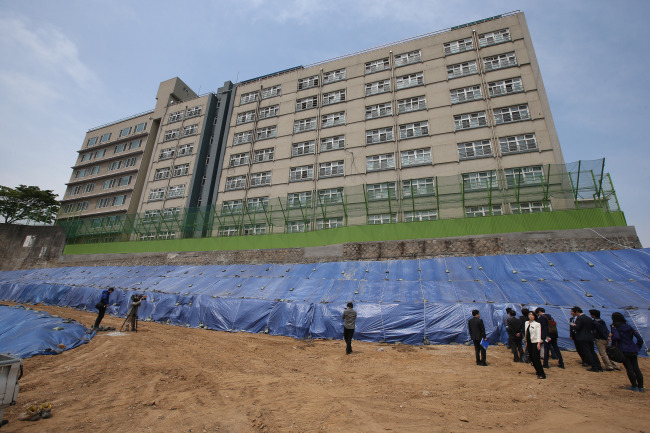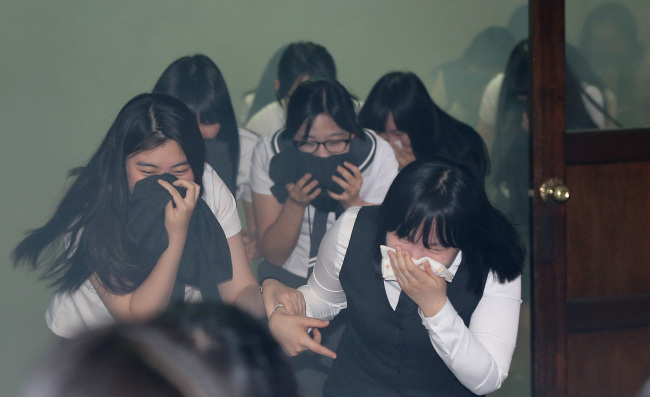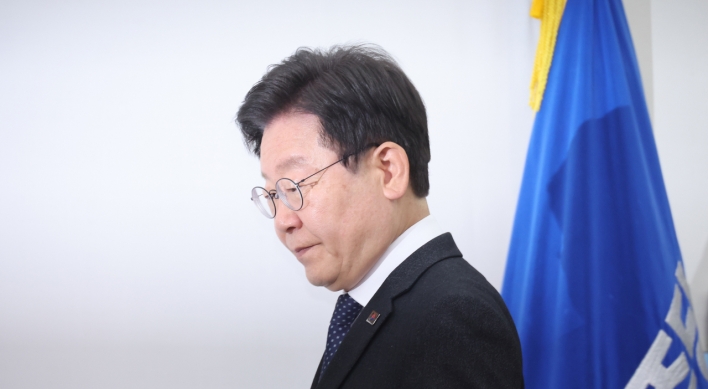[Ferry Disaster] Safety fears spread to school grounds
By Yoon Min-sikPublished : May 15, 2014 - 21:08
This is the second in a series of articles that examine Korean’s preparedness for disasters and social risks in light of the recent Sewol tragedy. ― Ed.
A seven-story building at Hwanil Middle and High School stands precariously on the edge of a hill in Jung-gu, central Seoul. Tons of dirt and rocks that once covered the building’s support structures have been cleared away, leaving the foundations struggling to support the immense weight of the building and hundreds of students.
When the construction of a parking lot began at the foot of the school this year, locals, teachers and parents of the students raised safety concerns.
“In the process of constructing an apartment, (the developers) basically sliced away part of a mountain. What kind of damage will be inflicted upon the school building that hosts about 800 students?” Park Si-ha, the vice principal of Hwanil Middle School, told the Korea Herald.
“The school told them the construction should start only after ensuring the safety of the children.”
Last month, the Seoul Metropolitan Office of Education stepped in and temporarily halted the construction. It also ordered the developers to conduct a safety check while taking supplementary measures to prevent possible disasters.
The move sounds appropriate, even if it was the first time the education office had ever put the brakes on school-related construction because of safety hazards. The apparent nonchalant attitude toward safety demonstrates the gaping holes in the nation’s ability to provide a safe learning environment.
Are schools safe?
The recent sinking of ferry Sewol that claimed over 200 lives highlighted the insensitivity toward safety throughout society. Most of the victims were high school students on a school trip, and the tragedy sparked a fierce debate about the safety of school excursions.
While some argued that field trips should be banned altogether, others started ashing “Are schools themselves safe places?”
A 27-year-old man recalled an incident during his high school days when his friend was run over by a dump truck that emerged from a blind spot behind one of the walls in the school. It was only after the accident ― which caused his friend to spend over a year in the hospital ― that the school decided to prohibit trucks from entering the premises during school hours.
According to Education Ministry data revealed by Rep. Lee Cha-ik of the Saenuri Party, the number of accidents within schools increased by more than 50 percent from 2008 to 2013, but the percentage of schools with nurses remained virtually the same, at around 65 percent.
Ministry data from Rep. Yoon Kwan suk of the New Politics Alliance for Democracy showed that 123 school buildings across the country required immediate repair, while another 1,307 required intensive monitoring. The Education Ministry, however, has yet to unveil its plans to financially support the work.
The mother of one of Hwanil’s students said she even considered transferring his son to another school. “It’s my boy’s life that’s important. Preparing for college? That’s nothing,” she said.
Damage control
The Sewol disaster, during which most of those responsible for preventing and dealing with the accident showed a humiliating lack of readiness, was an alarming bell for the nation to start improving its ability to protect the students.
Earlier this month, the Seoul education office started carrying out safety inspections on some 2,000 educational facilities across the city. It was in response to President Park Geun-hye’s instruction to ensure that tragic events like the Sewol disaster do not occur again.
Other education offices, such as those in Sejong City and South Chungcheong Province also began comprehensive inspections, while Seoul National University toyed with the idea of conducting regular safety checks on all buildings.
While it is immensely important to make sure the students do not get hurt when using the school facilities, it is not the end of the story.
Parents and teachers at Hwanil School recently started another battle to get the parking lot entrance moved away from the school zone.
“An entrance to a parking lot for over 200 households would be on a small road that students use to go to school. If you count other schools around the area, over 4,000 students use that road. It’s already overcrowded as it is,” said Vice Principal Park.
A seven-story building at Hwanil Middle and High School stands precariously on the edge of a hill in Jung-gu, central Seoul. Tons of dirt and rocks that once covered the building’s support structures have been cleared away, leaving the foundations struggling to support the immense weight of the building and hundreds of students.
When the construction of a parking lot began at the foot of the school this year, locals, teachers and parents of the students raised safety concerns.
“In the process of constructing an apartment, (the developers) basically sliced away part of a mountain. What kind of damage will be inflicted upon the school building that hosts about 800 students?” Park Si-ha, the vice principal of Hwanil Middle School, told the Korea Herald.
“The school told them the construction should start only after ensuring the safety of the children.”
Last month, the Seoul Metropolitan Office of Education stepped in and temporarily halted the construction. It also ordered the developers to conduct a safety check while taking supplementary measures to prevent possible disasters.
The move sounds appropriate, even if it was the first time the education office had ever put the brakes on school-related construction because of safety hazards. The apparent nonchalant attitude toward safety demonstrates the gaping holes in the nation’s ability to provide a safe learning environment.
Are schools safe?
The recent sinking of ferry Sewol that claimed over 200 lives highlighted the insensitivity toward safety throughout society. Most of the victims were high school students on a school trip, and the tragedy sparked a fierce debate about the safety of school excursions.
While some argued that field trips should be banned altogether, others started ashing “Are schools themselves safe places?”
A 27-year-old man recalled an incident during his high school days when his friend was run over by a dump truck that emerged from a blind spot behind one of the walls in the school. It was only after the accident ― which caused his friend to spend over a year in the hospital ― that the school decided to prohibit trucks from entering the premises during school hours.
According to Education Ministry data revealed by Rep. Lee Cha-ik of the Saenuri Party, the number of accidents within schools increased by more than 50 percent from 2008 to 2013, but the percentage of schools with nurses remained virtually the same, at around 65 percent.
Ministry data from Rep. Yoon Kwan suk of the New Politics Alliance for Democracy showed that 123 school buildings across the country required immediate repair, while another 1,307 required intensive monitoring. The Education Ministry, however, has yet to unveil its plans to financially support the work.
The mother of one of Hwanil’s students said she even considered transferring his son to another school. “It’s my boy’s life that’s important. Preparing for college? That’s nothing,” she said.
Damage control
The Sewol disaster, during which most of those responsible for preventing and dealing with the accident showed a humiliating lack of readiness, was an alarming bell for the nation to start improving its ability to protect the students.
Earlier this month, the Seoul education office started carrying out safety inspections on some 2,000 educational facilities across the city. It was in response to President Park Geun-hye’s instruction to ensure that tragic events like the Sewol disaster do not occur again.
Other education offices, such as those in Sejong City and South Chungcheong Province also began comprehensive inspections, while Seoul National University toyed with the idea of conducting regular safety checks on all buildings.
While it is immensely important to make sure the students do not get hurt when using the school facilities, it is not the end of the story.
Parents and teachers at Hwanil School recently started another battle to get the parking lot entrance moved away from the school zone.
“An entrance to a parking lot for over 200 households would be on a small road that students use to go to school. If you count other schools around the area, over 4,000 students use that road. It’s already overcrowded as it is,” said Vice Principal Park.

Even without the 200 some cars in the equation, a parade of dump trucks and construction vehicles will flood the narrow street once the construction kicks off.
The school is not the only one facing nearby safety risks. School zones often lack sidewalks, and as a result, students are forced to walk in the same lanes as vehicles.
Parents say there are also other objects threatening the safety of children.
“Kids from my son’s school are exposed to unattended gas canisters on their way to school. Boys often hit or play with them. It’s terrifying to think that the canisters might accidentally go off,” said the mother of a 6th-grade boy living in Busan.
Safety education critical
In keeping with the sudden surge of interest in safety, candidates for the upcoming Seoul education chief election came up with pledges to enhance security within schools.
Their promises, however, were met with skepticism.
“The candidates were vague on how the new plans would be financially supported. A policy without a budget is a fiction,” said Lee Kwang-jae, an official from civic group Korea Manifesto Center.
Experts said it was important for schools to train students on how to cope with disasters, for which most advanced countries put in immense effort.

In California, it is customary for schools to conduct regular earthquake drills. Japan requires all students to acquire minimal swimming skills via school classes.
“Koreans basically are not very safety-conscious. We think ‘Oh, the possibility of an accident is only 0.1 percent, so it’s okay’,” said professor Kim Gil-soo of Korea Maritime and Ocean University. “Even when there is one thousandth of a percent chance of an accident, we have to be careful.”
Kim, formerly the captain of a ship, said students as well as adults are poorly educated and do not know what to do in the face of accidents.
He said education is key for making people to realize the importance of safety. If children are taught to value safety, the social consensus is likely to change by the time they grow up to become decision makers.
Yang Jung-ho, a professor of education at Sungkyunkwan University, said the biggest issue was that the few schools that actually conduct safety drills do not take them seriously.
“They just think it’s a routine activity. They don’t regard it as preparing for an accident that might actually happen to them,” he said.
Yang suggested that safety-related education into the curriculum. “The primary objective should be to include safety lessons in actual school classes, not just as part of an extracurricular activity.
The fundamental solution is to equip students with survival skills, said Hong Hoo-jo, a professor of education at Korea University.
“Of all the sports, swimming is the only sport that helps you in a life or death situation. Schools should make it a requirement for graduation,” said Hong. He said students should learn lifesaving techniques and swimming skills by the time they graduate from middle school.
“There will be accidents, no matter what. The important thing is for children to be able to protect themselves and their friends.”
By Yoon Min-sik (minsikyoon@heraldcorp.com)





![[Herald Interview] 'Amid aging population, Korea to invite more young professionals from overseas'](http://res.heraldm.com/phpwas/restmb_idxmake.php?idx=644&simg=/content/image/2024/04/24/20240424050844_0.jpg&u=20240424200058)












![[KH Explains] Korean shipbuilding stocks rally: Real growth or bubble?](http://res.heraldm.com/phpwas/restmb_idxmake.php?idx=652&simg=/content/image/2024/04/25/20240425050656_0.jpg&u=)

